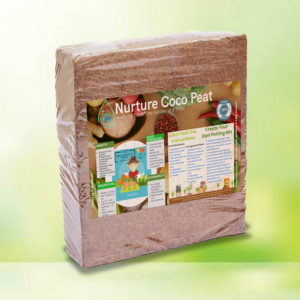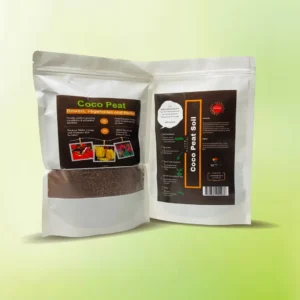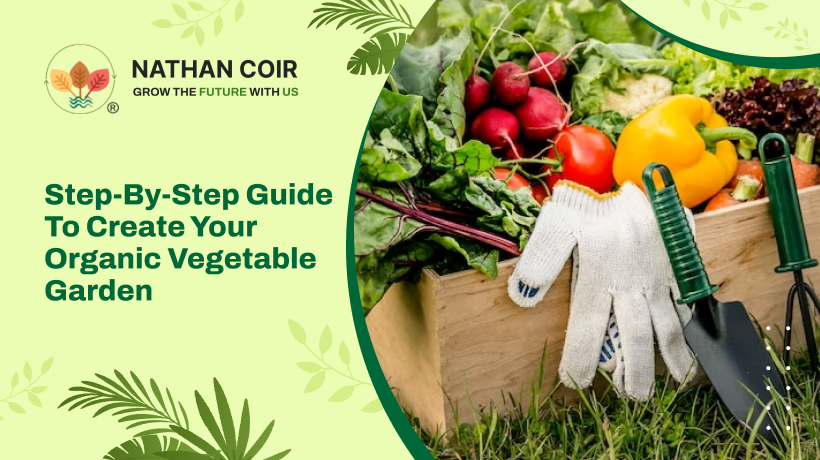Introduction
A satisfying and environmentally friendly way to savor fresh, chemical-free produce is to grow your own organic vegetable garden. More individuals are planting organically as worries about chemical fertilizers and pesticides in store-bought veggies grow. Whether you have a backyard, a balcony, or a little plot of ground, you can start your own organic vegetable garden with ease. One great way to enhance your garden is by using coco peat online, which provides excellent moisture retention and nutrient-rich soil for your plants. This article will guide you step by step on how to begin your journey into organic gardening. Let’s get started!
Choosing the Right Location
Importance of Location Selecting the right location is crucial for the success of your Organic Vegetable Garden. Vegetables thrive in well-lit areas with good soil and drainage. A well-chosen spot will maximize plant health and yield.
Factors to Consider
Sunlight: Most vegetables require at least 6–8 hours of direct sunlight per day. Choose an area that gets consistent sun exposure.
Avoid low-lying areas where water may collect in order to promote soil drainage.
Well-drained soil promotes healthy plant growth and prevents root rot.
Water supply proximity: Having a nearby water source makes it easier to water your plants and ensures they receive the moisture they need.
Protection from Wind and Bugs: Plant next to a fence or other natural barrier to shield your plants from strong winds and bugs.
Preparing the Soil
Understanding Soil Health The foundation of a thriving Organic Vegetable Garden is nutrient-rich organic garden soil for vegetables. Before planting, assess the soil quality to determine its suitability for organic gardening.
Steps to Prepare the Soil
Test the Soil: Check for pH levels and nutrient content using a soil testing kit. Most vegetables prefer a slightly acidic to neutral pH (6.0–7.0).
Improve Soil Structure: If the soil is too sandy or clay-heavy, add organic compost to help with drainage and structure.
Add Nutrients: Use natural fertilizers like compost, worm castings, and manure to improve soil fertility.
Aerate the Soil: Break up compacted soil with a garden fork or tiller. This ensures proper root development and water absorption.
Selecting Seeds and Planting
Choosing the Right Seeds Select organic and non-GMO seeds to maintain the integrity of your organic food crop. Select seeds that are suited to the local soil and climate.
Techniques for Planting
Plan the Garden Layout: Plants should be arranged according to their growth patterns, space needs, and the advantages of companion planting.
How to Properly Plant Seeds: Observe the depth and spacing guidelines on the seed packet. Poor growth and the spread of disease are two consequences of overcrowding.
Water Often: Keep the soil moist on a regular basis but avoid overwatering it. Water sparingly so as not to disturb newly planted seeds.
Mulch for Protection: Apply a layer of organic mulch to regulate soil temperature, prevent weed growth, and retain moisture.
Using Cocopeat for Soil Enhancement
Coconut husks are used to make cocopeat, sometimes referred to as coir pith, a natural, biodegradable growth medium. It’s used extensively in organic gardening and works wonders as a soil conditioner.
The use of cocopeat has the advantage of retaining moisture, which lessens the need for frequent watering.
Enhances Aeration: It improves the structure of the soil, making it easier for roots to take in oxygen.
Sustainable Substitute: Cocopeat, in contrast to peat moss, is a renewable and sustainable resource.
Improves Absorption of Nutrients: It makes it easier for plants to absorb nutrients.
How to Use Cocopeat in Your Garden
Hydrate Cocopeat Blocks: Soak dry cocopeat blocks in water until they expand and become soft.
Mix with Soil: Combine cocopeat with organic garden soil for vegetables in a 1:1 ratio.
Use as Mulch: Spread cocopeat around plants to help retain moisture and prevent weeds.
Natural Pest and Weed Control
Avoiding Chemical Pesticides One of the biggest advantages of an Organic Vegetable Garden is avoiding harmful pesticides. Instead, use natural methods to keep pests and weeds at bay.
Organic Pest Control Methods
Companion Planting: Grow pest-repelling plants like marigolds, basil, and garlic alongside vegetables.
Handpicking Pests: Regularly inspect your plants and remove any pests by hand.
Encourage Beneficial Insects: Ladybugs, spiders, and bees help control pest populations naturally.
Organic Weed Management
Mulching: By obstructing sunlight, a thick layer of mulch stops weeds from growing.
Hand Weeding: Before weeds spread, pull them by hand.
Vinegar Spray: To eradicate weeds without damaging your vegetables, use a diluted vinegar solution.
Conclusion
You can grow fresh, healthful vegetables in your backyard by using natural methods and careful planning, even if starting an organic vegetable garden may seem difficult at first. By picking the ideal spot, cultivating veggies in nutrient-rich organic garden soil, using organic seeds, and utilizing eco-friendly growing techniques like cocopeat for plants, you can produce a healthy garden free of dangerous chemicals. Furthermore, using organic weed and pest management will assist in guaranteeing a plentiful crop. Therefore, why wait? Get your garden started with Nathan Coir Cocopeat and enjoy the rewards of organic, chemical-free produce!




